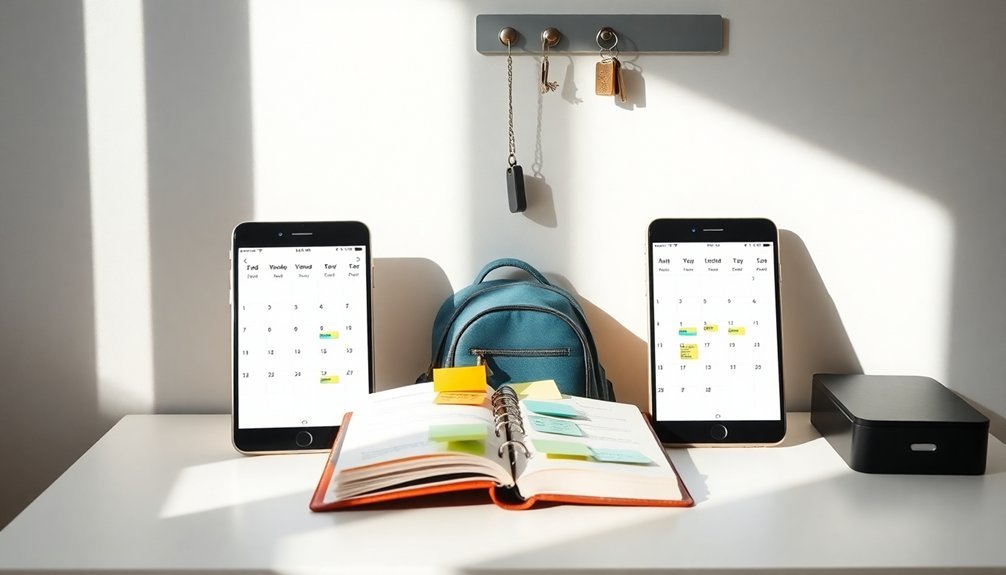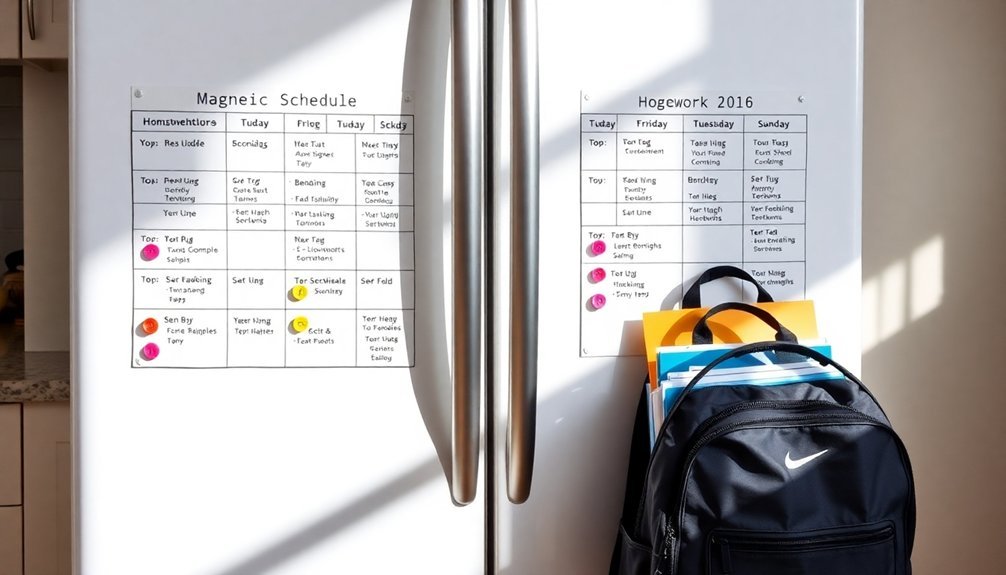When Sarah and Mike divorced last year, their first challenge wasn't the paperwork—it was figuring out how to effectively co-parent their two young children without letting their personal conflicts interfere. You'll find that establishing clear boundaries in co-parenting isn't just helpful—it's vital for your children's well-being and your own peace of mind. While you might think you've covered all the bases with a basic custody agreement, there's a whole set of unwritten rules and boundaries that can make or break your co-parenting success. Let's explore the vital elements that'll help you create a stable, respectful, and healthy co-parenting relationship.
Key Takeaways
- Maintain strictly business-like communication focused on child-related matters, avoiding personal topics or emotional manipulation.
- Establish clear financial boundaries, including documentation of expenses and specific deadlines for reimbursements.
- Respect each household's privacy and autonomy while maintaining consistent core rules for children's stability.
- Set firm scheduling boundaries with advance notice requirements and designated response times for non-emergency changes.
- Keep all disagreements and adult discussions private from children, preserving their relationships with both parents.
Communication Ground Rules
Successful co-parenting starts with establishing clear communication protocols between both parents. When you set firm ground rules for interaction, you'll create a stable foundation that benefits both you and your children.
Commit to active listening during discussions, focusing on understanding rather than reacting to your co-parent's perspective. Choose appropriate communication channels that work for both parties, whether it's email, a co-parenting app, or scheduled phone calls.
Maintain a respectful tone in all exchanges, even during disagreements, and stick to child-related topics only. You'll want to document important conversations and agreements in writing to prevent future misunderstandings.
Set specific response timeframes for non-emergency matters, typically 24-48 hours, while establishing clear protocols for urgent situations. When communicating, use "I" statements to express concerns without blame, and keep emotional triggers in check.
Remember to share important information about your children's health, education, and activities promptly. If face-to-face meetings are necessary, choose neutral locations and stay focused on the agenda.
These boundaries will help you maintain a business-like relationship that prioritizes your children's well-being.
Scheduling and Time Management

Managing schedules effectively with your co-parent requires clear communication about changes and a reliable system for tracking your child's activities.
You'll benefit from establishing a shared digital calendar that both parents can access and update in real-time, making it easier to coordinate appointments, school events, and extracurricular activities.
Setting up user-friendly scheduling tools like Google Calendar or specialized co-parenting apps can help you maintain organization and reduce potential conflicts over time management.
Clear Communication About Changes
Flexibility in co-parenting schedules requires clear protocols for communicating changes and adjustments. When you establish consistent change notification procedures, you'll reduce conflict and maintain stability for your children.
Both parents need to agree on the communication style and response expectations for schedule modifications.
Set these essential boundaries for communicating changes:
- Send change requests in writing through your agreed-upon platform (text, email, or co-parenting app), and avoid verbal-only arrangements that can lead to misunderstandings.
- Provide reasonable notice for non-emergency schedule changes (ideally 48-72 hours minimum) to allow both parents to adjust their plans.
- Include specific details about the proposed change, including dates, times, and reason for the modification.
- Acknowledge receipt of change requests within an agreed-upon timeframe (usually 24 hours).
Remember that successful co-parenting relies on mutual respect for these communication protocols.
When you can't avoid last-minute changes, follow your established emergency procedures and document all communications. This structured approach helps maintain clear boundaries while allowing for necessary flexibility in your parenting schedule.
Child Activity Calendar System
A well-organized calendar system forms the backbone of effective co-parenting time management. By implementing a shared digital calendar specifically dedicated to your child's activities, you'll create transparency and reduce potential scheduling conflicts between households.
Set up your child activity calendar to include essential details like sports practices, medical appointments, school events, and extracurricular commitments. Most co-parents find success using platforms like Google Calendar or specialized co-parenting apps that offer calendar sharing features.
Make it a habit to update the calendar immediately when new activities arise.
Establish clear protocols for calendar management: who can add events, how much advance notice is required for schedule changes, and how to handle conflicts when they occur. You'll want to include specific pick-up and drop-off times, locations, and which parent is responsible for transportation to each activity.
Remember to grant calendar access to other important caregivers, such as grandparents or regular babysitters, when appropriate. This guarantees everyone involved in your child's care stays informed and coordinated.
Set up automatic notifications for upcoming events to help maintain smooth shifts between households.
Digital Scheduling Tools Guide
Today's digital landscape offers numerous tools specifically designed for co-parenting coordination. When you're managing shared custody, digital calendar integration becomes essential for maintaining clear communication and avoiding scheduling conflicts. Many co-parenting apps now provide extensive scheduling features that sync with your existing calendars while maintaining privacy boundaries.
To maximize the effectiveness of your digital scheduling system, consider these proven tools and features:
- Dedicated co-parenting apps like OurFamilyWizard or AppClose that offer court-admissible communication records and scheduling reminders
- Cloud-based shared calendars with color-coding options to distinguish between each parent's time and important events
- Automated notification systems that alert both parents about upcoming changes, medical appointments, or school activities
- Multi-device synchronization capabilities that guarantee everyone stays updated regardless of their preferred platform
When selecting your digital scheduling tool, focus on features that promote transparency while respecting boundaries.
You'll want to verify the platform you choose allows for clear documentation of schedule changes and provides a neutral space for coordinating adjustments.
Remember that consistency in using these tools helps establish reliable communication patterns between co-parents.
Financial Responsibilities

Sorting out financial responsibilities stands at the core of successful co-parenting arrangements. Clear agreements about child support and expense sharing help prevent conflicts and guarantee your children's needs are consistently met. You'll need to establish transparent systems for tracking, documenting, and communicating about financial matters.
| Expense Type | Primary Parent | Shared Costs |
|---|---|---|
| Daily Needs | Food, clothing | Medical bills |
| Activities | School lunches | Sports fees |
| Education | School supplies | Tuition |
Create a detailed financial plan that outlines who's responsible for specific expenses. You'll want to document your agreements about handling unexpected costs, periodic expenses like school supplies, and long-term financial goals for your children. Consider using dedicated apps or spreadsheets to track shared expenses, maintaining receipts, and setting up regular financial check-ins with your co-parent.
Remember to keep financial discussions separate from other co-parenting matters. When you establish clear boundaries around money management, you're laying the groundwork for a stable co-parenting relationship that benefits your children's well-being and reduces potential stress points between parents.
Personal Space and Privacy

Maintaining healthy boundaries around personal space and privacy forms an essential foundation for effective co-parenting relationships.
When you establish clear personal boundaries and respect individual privacy, you create a more stable environment for both co-parents and children.
It's vital to define these boundaries early and communicate them respectfully to prevent misunderstandings and conflicts.
Consider implementing these essential privacy guidelines in your co-parenting arrangement:
- Respect each other's homes as separate spaces – don't enter without explicit invitation, even if you used to live there
- Keep personal relationships private – avoid discussing new partners unless they'll be involved with the children
- Maintain separate social media accounts and don't share photos of your co-parent without permission
- Establish clear communication channels and times – avoid constant messaging or late-night calls unless it's an emergency
Remember that healthy personal boundaries don't mean being unfriendly – they simply create structure and respect between co-parents.
When you honor each other's individual privacy, you model healthy relationships for your children and create a more peaceful co-parenting dynamic that benefits everyone involved.
New Partners and Dating

Building on the foundation of personal boundaries, introducing new romantic partners requires thoughtful consideration and clear guidelines in co-parenting relationships.
You'll need to establish protocols that protect your children's emotional well-being while respecting everyone's right to move forward.
When managing new relationship dynamics, communicate with your co-parent before introducing a new partner to your children. Agree on timing, circumstances, and how you'll manage these changes.
Consider waiting until your relationship is stable and serious before making introductions, typically at least 6-12 months into dating.
Set clear expectations with your new partner about their role, ensuring they understand and respect existing co-parenting arrangements.
Partner introductions should happen gradually, in neutral settings, and without pressure for immediate bonding. Remember that your children need time to process these changes.
Create specific guidelines about your new partner's involvement in parenting decisions, school events, and family gatherings.
Document these agreements to prevent misunderstandings. If tensions arise, remain focused on your children's needs and consider working with a family therapist to manage complex emotions and adjustment periods.
Decision Making Protocol

Clear decision-making channels serve as the foundation for successful co-parenting, so you'll want to establish specific methods for communicating about important choices affecting your child.
Your communication protocols should outline which decisions require mutual agreement (like education, medical care, and religious upbringing) versus daily choices that can be made independently by each parent.
Setting up a shared digital platform or regular check-in schedule can help you maintain consistent joint authority while respecting each parent's autonomy within agreed-upon parameters.
Clear Communication Channels
Successful co-parenting hinges on establishing reliable channels for making decisions about your children's lives.
Today's technology offers various co-parenting apps that can streamline your communication and create a documented history of agreements. When you establish clear texting protocols and communication boundaries, you'll reduce misunderstandings and maintain a more peaceful co-parenting relationship.
Choose communication methods that work for both parties and stick to them consistently. Remember that effective channels aren't just about the medium you use – they're about creating a structured, respectful dialogue that keeps your children's interests at the forefront.
- Use dedicated co-parenting apps for scheduling, expense tracking, and document sharing to maintain transparency
- Establish specific time windows for non-emergency communication to respect each other's boundaries
- Create a shared calendar system that both parents can access and update regularly
- Agree on response timeframes for different types of communications (urgent vs. routine matters)
When you implement these clear channels, you'll find that decision-making becomes more streamlined and less emotionally charged.
This structured approach helps maintain focus on what matters most: your children's well-being.
Joint Authority Guidelines
Three fundamental aspects define effective joint authority in co-parenting: major decisions, day-to-day choices, and emergency protocols.
For major decisions, establish a joint decision making framework that addresses your child's education, medical care, religious upbringing, and extracurricular activities.
You'll need to create a process for discussing, evaluating, and reaching consensus on these significant matters. Set regular meetings or calls specifically dedicated to these discussions.
When it comes to day-to-day choices, define clear boundaries around shared parenting responsibilities.
Determine who makes routine decisions during their designated parenting time, such as bedtime, homework supervision, and social activities.
While you should respect each other's parenting styles, maintain consistent core rules across both households.
For emergency situations, develop a clear protocol that outlines who to contact first, what constitutes an emergency, and how to handle urgent medical decisions.
Create a shared document with emergency contacts, insurance information, and your child's medical history.
Remember to update both parents immediately about any emergencies or urgent changes, regardless of whose parenting time it is.
Children's Emotional Well-being

Children's emotional stability must remain the top priority when establishing co-parenting boundaries. Your commitment to providing consistent emotional support and protecting your children's mental health will help them navigate the challenges of having separated parents.
You'll need to work together with your co-parent to create a nurturing environment that promotes psychological safety and healthy emotional development.
To safeguard your children's emotional well-being, implement these essential boundaries:
- Never discuss adult matters, legal issues, or conflicts with your children, allowing them to maintain positive relationships with both parents.
- Maintain consistent rules and expectations across both households to provide stability and reduce anxiety.
- Support your children's relationships with extended family members from both sides, fostering a sense of connection and belonging.
- Create safe spaces for your children to express their feelings without fear of disappointing either parent.
Remember that your children need to feel secure in both homes and shouldn't be burdened with adult responsibilities or emotional labor.
When you prioritize their emotional needs and maintain appropriate boundaries, you're helping them develop resilience and healthy coping mechanisms for the future.
Respect for Household Rules

Building upon the foundation of emotional well-being, establishing mutual respect for each household's rules creates a stable environment for your children. When you and your co-parent maintain clear household expectations, you're helping your children adapt to living in two homes while feeling secure in both.
Start by documenting your essential household rules and sharing them with your co-parent. While you don't need identical rules, you should aim for discipline consistency in key areas like homework completion, screen time limits, and behavioral standards. This alignment helps prevent your children from playing one parent against the other or becoming confused about boundaries.
If your co-parent's rules differ from yours, resist the urge to criticize them in front of your children. Instead, explain that different homes may have different expectations, just as school and home rules can vary.
When disagreements about rules arise, address them privately with your co-parent, focusing on the children's best interests. Consider creating a shared document outlining agreed-upon core rules that will remain consistent across both households, while respecting each parent's autonomy in establishing additional household-specific guidelines.
Social Media and Technology

Setting clear digital communication guidelines with your co-parent helps prevent misunderstandings and establishes healthy boundaries for everyone involved.
You'll want to outline specific protocols for how and when you'll communicate through texts, emails, or co-parenting apps, ensuring that all exchanges remain focused on your children's needs.
When it comes to sharing photos and updates on social media, establish mutual agreements about what can be posted about your children and consider creating a shared digital space where you both can access important moments and memories.
Digital Communication Guidelines
Modern technology presents unique challenges and opportunities for co-parents trying to maintain healthy boundaries while staying connected with their children. Following clear digital etiquette tips can help you navigate virtual communication more effectively while minimizing potential conflicts.
To maintain respectful digital boundaries and practice virtual conflict resolution, implement these essential guidelines in your co-parenting communication:
- Keep all digital conversations focused on child-related matters only, using business-like language that's free from emotional triggers or personal comments.
- Choose appropriate communication platforms (like dedicated co-parenting apps) rather than personal social media or casual messaging apps to maintain professionalism.
- Set specific "blackout hours" when non-emergency messages won't be sent, respecting each other's private time and reducing anxiety around constant connectivity.
- Document important conversations and agreements in writing, but avoid screenshot-taking or sharing private messages with others unless legally necessary.
Remember that your digital communication creates a permanent record that can impact your co-parenting relationship and potentially your legal standing.
Photo Sharing Protocol
According to research, photo sharing between co-parents can become a significant source of conflict and boundary violations in today's digital age. To maintain healthy co-parenting relationships, you'll need to establish clear photo sharing etiquette and respect privacy considerations for all parties involved.
Create specific guidelines about when and how you'll share photos of your children with each other. Decide on an agreed-upon platform or method, whether it's through a co-parenting app, shared cloud folder, or regular text messages. Set expectations for response times and acknowledge receipt of shared photos.
Establish rules regarding social media posts featuring your children. You'll want to address: consent before posting, appropriate content standards, tagging protocols, and privacy settings.
Consider creating a written agreement that outlines whether you need the other parent's permission before sharing photos publicly.
Remember to respect your co-parent's boundaries about photos taken during their parenting time. If you're unsure about sharing specific images, it's better to ask first. This promotes trust and demonstrates respect for your co-parent's role in your child's life.
Extended Family Boundaries

Extended family relationships can greatly impact your co-parenting dynamic. Managing these connections requires clear boundaries and open communication between both parents. When you establish consistent guidelines for extended family interactions, you'll create a more stable environment for your children while preserving important family bonds.
Consider these essential boundaries for extended family involvement:
- Set expectations with grandparents, aunts, and uncles about their roles in your children's lives, including appropriate communication channels and frequency of contact.
- Create guidelines for family gatherings and holiday celebrations that respect both parents' families and minimize potential conflicts.
- Establish protocols for how extended family members should handle sensitive information or disagreements between co-parents.
- Define boundaries around extended family's involvement in parenting decisions and discipline.
Remember that your extended family members might need time to adjust to these boundaries. Be firm but compassionate as they learn to navigate their new roles.
When both co-parents align on extended family boundaries, you'll reduce tension and create a more harmonious environment for everyone involved, especially your children.
Frequently Asked Questions
How Can I Cope With Co-Parenting When My Ex Is Hostile?
When facing a hostile ex, you'll need strong communication strategies to maintain your peace.
Keep interactions focused solely on the children and document everything.
Don't hesitate to seek emotional support through counseling or support groups – you're not alone in this challenge.
Consider using a co-parenting app or mediator to minimize direct conflict.
What Age Should Children Be Involved in Co-Parenting Decisions?
Child involvement in co-parenting decisions should align with their emotional maturity and age appropriateness.
While you shouldn't burden young children (under 8) with major decisions, you can start with simple choices like activities or meals.
As your children reach their teens, you'll want to give them more voice in scheduling and preferences.
Should We Tell Our Children Why We Divorced?
Like delicate seeds needing just the right amount of water, children's understanding of divorce requires careful balance.
You'll want to share age-appropriate information that helps them process without burdening them with adult complexities. It's okay to provide basic divorce reasons like "we couldn't solve our problems together," but avoid blame or detailed explanations.
Your children need reassurance that both parents love them and that the separation isn't their fault.
How Do We Handle Disagreements About Medical Treatment for Our Child?
When you face medical decision making conflicts, start by establishing clear treatment communication channels with your co-parent.
You'll want to share all medical information promptly and document discussions about treatment options.
If you can't agree, consider working with a family mediator who specializes in healthcare decisions.
What's the Best Way to Introduce Therapy to Resistant Children?
When therapy feels like pulling teeth, you'll need a gentle touch to help your child feel safe and heard.
Start by normalizing therapy through casual conversations, comparing it to a helpful coach or trusted friend. You can introduce therapy approaches through play, art, or storytelling activities they already enjoy.
Share age-appropriate examples of others who've found therapy helpful, and don't force it—let your child warm up at their own pace.
Conclusion
Proactively practicing proper co-parenting boundaries persistently promotes peace for all parties involved. You'll find that maintaining mindful, measured interactions creates a secure space for your children to thrive. When you're willing to work within these well-defined parameters, you'll build better relationships and foster fundamental family stability. Remember, reasonable responses and respectful routines reinforce responsible co-parenting, ultimately serving your children's successful future.








0 responses to “Essential Co-Parenting Boundaries Checklist”